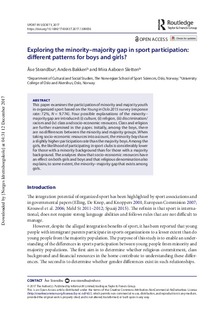Exploring the minority–majority gap in sport participation: Different patterns for boys and girls?
Journal article, Peer reviewed
Published version

View/
Date
2017-11-15Metadata
Show full item recordCollections
- Artikler / Articles [2096]
Original version
Sport in Society. 2017, doi:10.1080/17430437.2017.1389056 10.1080/17430437.2017.1389056Abstract
This paper examines the participation of minority and majority youth in organized sport based on the Young in Oslo 2015 survey (response rate: 72%, N=9.774). Four possible explanations of the minority–majority gap are introduced: (i) culture, (ii) religion, (iii) discrimination/racism and (iv) class and socio-economic resources. Class and religion are further examined in the paper. Initially, among the boys, there are no differences between the minority and majority groups. When taking socio-economic resources into account, the minority boys have a slightly higher participation rate than the majority boys. Among the girls, the likelihood of participating in sport clubs is considerably lower for those with a minority background than for those with a majority background. The analyses show that socio-economic resources have an effect on both girls and boys and that religious denomination also explains, to some extent, the minority–majority gap that exists among girls.
Description
This is an Open Access article distributed under the terms of the Creative Commons Attribution-NonCommercial-NoDerivatives License (http://creativecommons.org/licenses/by-nc-nd/4.0/), which permits non-commercial re-use, distribution, and reproduction in any medium, provided the original work is properly cited, and is not altered, transformed, or built upon in any way